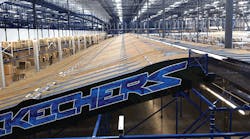The idea of a "bottom up" approach in a warehouse leading to higher productivity is long gone. For years, this practice was the only approach managers would use to drive more efficient operations.
But more recently, the perspective has changed: If managers truly want leaner processes, they must be at the center of an efficient warehouse strategy.
Managers must be advocates for their warehouses. They're the ones charged with forming a long-term strategic vision that involves both smart automation and intelligent warehouse organization. Teams change, after all, and without strong leadership from the top, effective strategies fade away.
But a resilient leader with a full-spectrum view of the supply chain, a clear goal of greater efficiency and a clear vision for how to achieve it will help improve the warehouse's performance year after year, continually streamlining operations.
Universal Principles
A thorough look at any warehouse's operations reveals that while the equipment may differ, the guiding principles that deliver efficiency stay the same: Decrease inventory while increasing system capacity and reducing operating costs.
Smart leaders realize this and weave those principles through their operations. A modified process doesn't do much good if it stays siloed in one department—a good manager will analyze how the change will improve overall warehouse efficiency.
Each part of the supply chain depends on the others, and something that impacts one part, such as a warehouse that has become overcrowded with inventory, will eventually ripple out to affect all others.
Lack of proper equipment in that packed warehouse increases the amount of labor required to complete a job. If one operator has to make 20 moves instead of one, fatigue will set in, the worker will move slower, and the warehouse will have to employ more people to get the job done.
But the scenario changes when a leader steps in who recognizes the big picture. Many managers are realizing that it makes sense to reorganize their warehouses based on customer ordering patterns. They analyze reams of data to uncover that their customers who buy bathing suits also frequently buy flip-flops, or people who order pens tend to also get paper.
Storing bathing suits near flip-flops and pens by paper all of a sudden makes a lot of sense. Managers must have the foresight to consider such reshuffling and the flexibility to actually do it in order to uncover hidden efficiencies that don't require additional equipment.
The Right Match
Most warehouses, of course, benefit from some degree of automation. A warehouse management system, for example, provides broad oversight and ensures everyone is on the same page with picking processes. The key, however, is to automate just where and when it makes sense. What works for a small startup doesn't always translate to a multibillion-dollar conglomerate.
But a strong leader looks not only at the moment but also projects into the future. It's smart to plan proactively for growth so that a small company that becomes a large company isn't encumbered with systems or processes that no longer fit the operation's scale. Design any solution with growth potential in mind—companies built on Internet fulfillment, in particular, can expand exponentially in just a few years.
Even within a single company, warehouses at different locations can vary tremendously in size with needs that range from those of a small business all the way up to a corporate behemoth. Over-automating doesn't help—it's all about seeking simple solutions that make sense with your operations.
Footware company Skechers, for example, runs a smaller operation in Brazil that processes 1-2 million units per year, mostly manually. But hop over to Belgium, and you'll see a much more mechanized operation that handles 10 million units each year. Finally, the Moreno Valley, Calif., location processes 17,000 pairs of shoes every hour in the largest LEED-certified building in the U.S. That simply wouldn't be possible without heavy automation.
Skechers has found the right balance of automation to achieve the greatest level of efficiency for each of its warehouse environments because, simply put, there's no one-size fits all approach.
And that's where leadership comes in: Managers see all the variations and nuances. They understand how the systems work together and can adapt a strategy that succeeded in one warehouse environment so it accommodates operations in another.
A view from the top gives a clear perspective on warehouse efficiency and will help your operations rise to a more efficient future.
Bob Liebe is division president of the Warehouse Equipment Store at Wynright Corp., a wholly owned subsidiary of Daifuku Webb and a U.S.-based provider of intelligent material handling systems. With more than 200 engineers in-house, Wynright designs, manufactures, integrates and installs intralogistics solutions, offering both Wynright-branded and third-party equipment.



